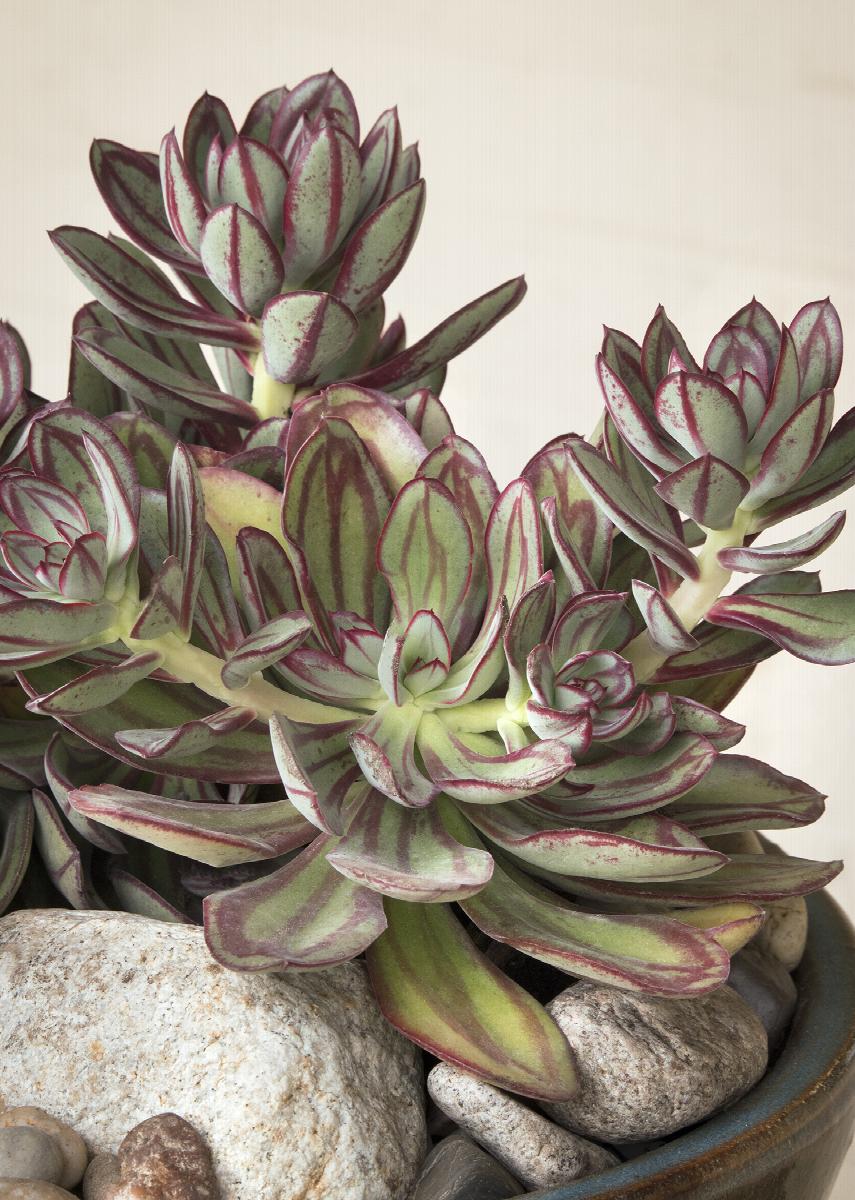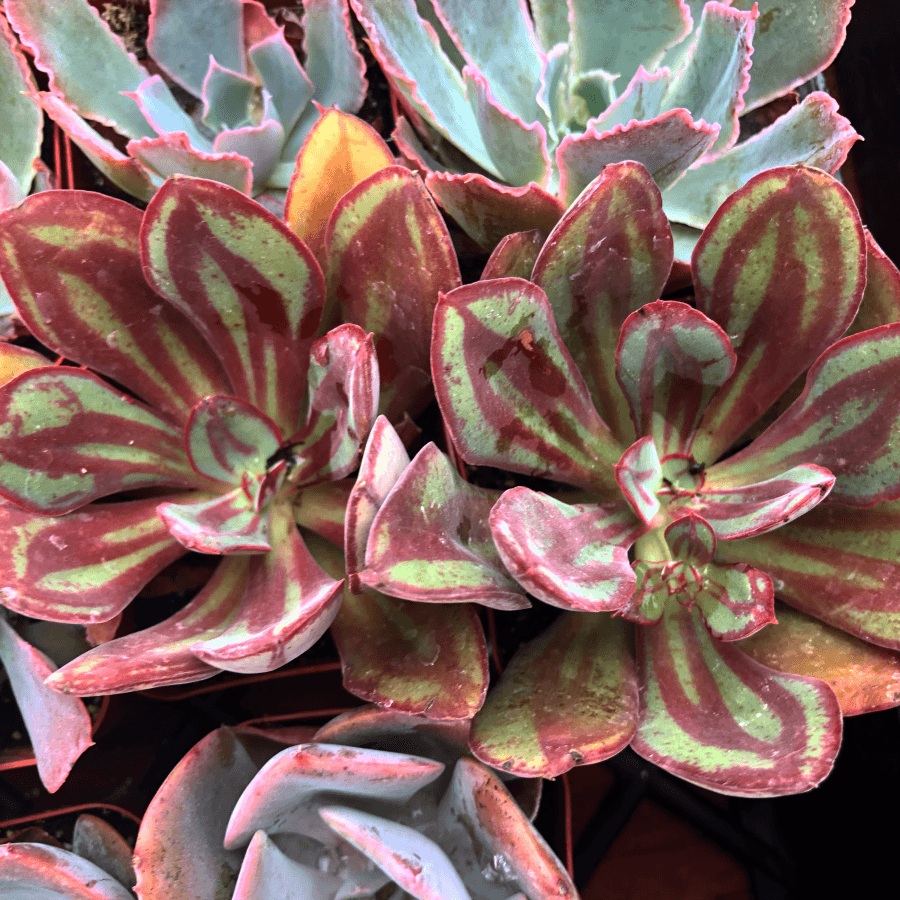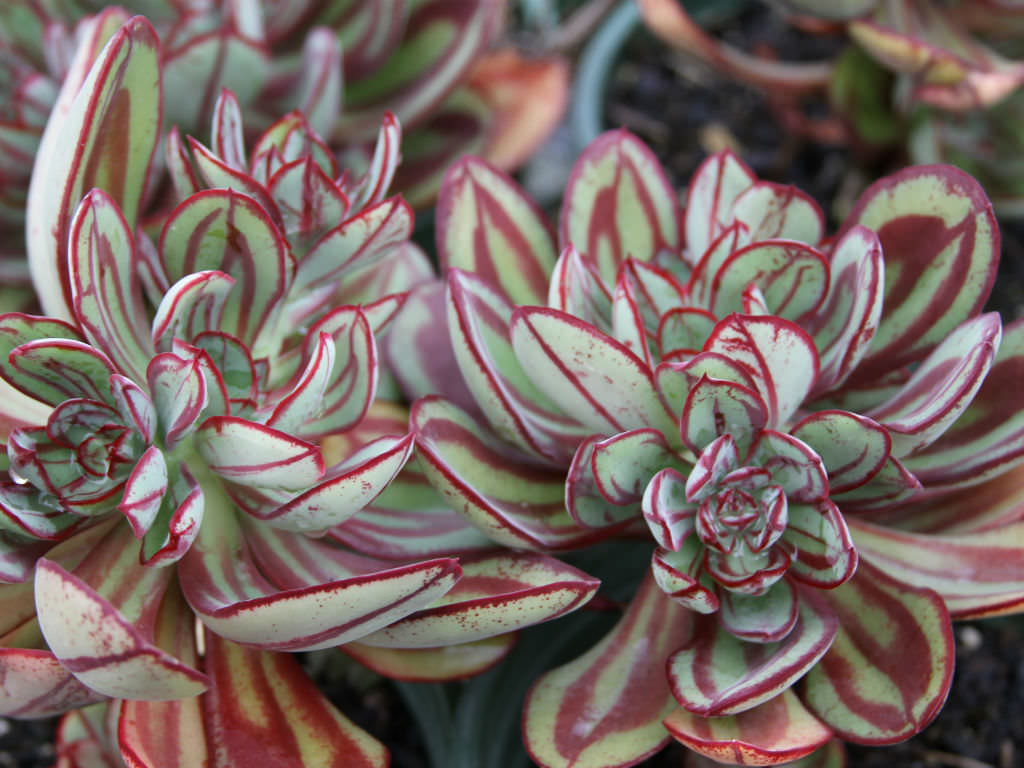This lime green succulent has red edges on the leaves and stems that spread out and produce smaller versions of itself. In the summer, it’s possible to see pink or yellow flowers bloom on the plant. Propagation is easy, as the offsets can be removed and planted.
Table of Contents
Care and Propagation Information
This species of Echeveria grows in mounds of up to 2 feet (61cm) tall and 3 feet (.9 m) wide. To keep the plant small and neat in arrangements, you can trim the branches and propagate the offsets that grow.
Watering
For “Painted Echeveria” to thrive, it is best to use the “soak and dry” watering technique. This means allowing the soil to become completely dry between waterings.
Be sure to grab our complimentary watering cheat sheet so you can learn how to recognize if your succulents are being overwatered and how to salvage them if need be.
Where to Plant
If you’re in an area where temperatures drop below 30° F (-1.1° C), it would be wise to grow Echeveria nodulosa “Painted Echeveria” in a pot and bring it inside during cold weather. This succulent thrives in full to partial sunlight.
For planting indoors, ensure that the room you pick is well-lit, especially if it is south-facing in the Northern Hemisphere. If the plants seem to be reaching for more light, relocate them to a spot with more sunlight or use a grow light to supplement.
How to Propagate Echeveria nodulosa “Painted Echeveria”
One way to propagate Echeveria nodulosa “Painted Echeveria” is to take cuttings from the leaves and grow them in soil.
Cuttings
To propagate a “Painted Echeveria”, use a sharp and sterile knife or pair of scissors to make a cutting. Let the cut heal for a few days before planting it into a soil that drains well.
Leaves
To propagate “Painted Echeveria,” take a leaf off the mother plant and twist it so that no part of it stays on the stem. Doing so will increase the chances of success.
Let the leaf sit for a few days until the end has sealed over, then put it in a pot that drains well. Water only when the soil is completely dry.
Care and Propagation Information
General Care for Echeveria nodulosa “Painted Echeveria”
Watering
For “Painted Echeveria” to thrive, it is best to use the “soak and dry” watering technique. This means allowing the soil to become completely dry between waterings.
Be sure to grab our complimentary watering cheat sheet so you can learn how to recognize if your succulents are being overwatered and how to salvage them if need be.
Where to Plant
If you’re in an area where temperatures drop below 30° F (-1.1° C), it would be wise to grow Echeveria nodulosa “Painted Echeveria” in a pot and bring it inside during cold weather. This succulent thrives in full to partial sunlight.
For planting indoors, ensure that the room you pick is well-lit, especially if it is south-facing in the Northern Hemisphere. If the plants seem to be reaching for more light, relocate them to a spot with more sunlight or use a grow light to supplement.
How to Propagate Echeveria nodulosa “Painted Echeveria”
One way to propagate Echeveria nodulosa “Painted Echeveria” is to take cuttings from the leaves and grow them in soil.
Cuttings
To propagate a “Painted Echeveria”, use a sharp and sterile knife or pair of scissors to make a cutting. Let the cut heal for a few days before planting it into a soil that drains well.
Leaves
To propagate “Painted Echeveria,” take a leaf off the mother plant and twist it so that no part of it stays on the stem. Doing so will increase the chances of success.
Let the leaf sit for a few days until the end has sealed over, then put it in a pot that drains well. Water only when the soil is completely dry.
FAQ
What is the most prolific Echeveria?
(15-25 cm) stalks.
Echeveria prolifica is an incredibly prolific evergreen succulent with soft, pale silvery-green leaves that have a hint of pink. During the springtime, it produces clusters of cheerful, yellow flowers on stalks that measure between 6 to 10 inches.
Does Echeveria need sun or shade?
Paraphrase: Sunlight: Providing enough sunlight is a common mistake made by succulent gardeners. Be sure to place your echeveria in a window that receives six or more hours of direct sunlight per day. Without sufficient light, your echeveria will become thin and leggy, losing its attractive, compact shape.
What is the biggest Echeveria in the world?
Echeveria gibbiflora is the biggest type of echeveria, and is the parent of many of the popular large, cabbage-shaped echeveria hybrids.
What is the most beautiful Echeveria?
Echeveria perle von Nurnberg is a well-known species of echeveria, which is recognized by its single rosette of paddle-shaped, pale leaves. Its foliage takes on a grayish tone in lower light environments, but when exposed to full and direct sun, its leaves show a vibrant pink and purple hue.
What is the most common Echeveria?
This particular echeveria is easily identified by its distinct rosette shape and its vibrant colors in direct sunlight.



